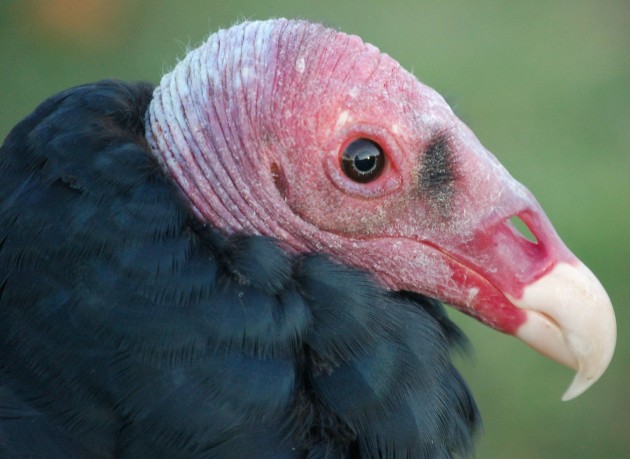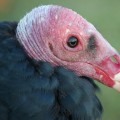It is one of the most sensitive noses in the animal kingdom but what its owner seeks is no pungent bed of roses, in fact quite the opposite. Experts estimate that Cathartes aura, or the turkey vulture, can detect the scent of rotting flesh in concentrations as tiny as a few parts per billion in the air. “They track plumes of odor from decaying animals while gliding high up in the air column and home in on it by flying in circles,” explains Gary Graves, an ornithologist in the Division of Birds at the Smithsonian’s National Museum of Natural History. “They go ‘upstream’ to the densest part of the olfactory gradient–it gets stronger and stronger–until they find the source. Their sense of smell is so acute that they can even locate hidden food, say something as small as a dead rat under a pile of leaves, Graves says.

This image of a turkey vulture shows the large, well-developed nostrils which allow these birds to detect the faintest scent of carrion from high in the air. (Photo by Dario Niz / Wikimedia Commons)
Graves is co-author of a recent paper in the scientific journal The Anatomical Record that compares the eye morphology and vision of the turkey vulture with that of Coragyps atratus or the black vulture, a bird experts believe has a “only a rudimentary sense of smell,” Graves says. Here, Graves answers a few questions about this unusual comparative study.
Q: What was the aim of this study?
Graves: It is logical to think that there might be some kind of compensatory reduction in the visual powers of the turkey vulture since they have such an exquisite olfactory sense. Metabolically, sensory systems are expensive and specialization in one area can result in an evolutionary trade-off where other senses become regressed. Our thinking was ‘if you can smell your way to a food source do you really need to have super-good eyesight?’ We wanted to test this hypothesis by comparing the eyesight of the turkey vulture against that of another vulture species that does not have such a keen sense of smell. We predicted turkey vultures would have smaller eyes and weaker vision than black vultures.
Q: What did you find?
Graves: Surprisingly, we found that both the turkey vulture and the black vulture have about the same acuity of vision. Eye size relative to body mass, eye shape and retinal structure are very similar in both birds. The theory of compensatory reduction did not bear out in this case. This is a new discovery. Very little is known about vision in vultures.
Q: How did the team determine the acuity of vision in these birds?
Graves: We first did basic external measurements of the eyes of dead birds with calipers, measuring lens diameter and diameter and shape of the entire eye, and also the ratio of the weight of the eye in relation to overall body mass. Next we examined the density of the tiny visual receptors on the retina. It is similar to opening an orange, flattening the peel and then counting the cells on the peel surface with a microscope. A retina with a low density of photoreceptor cells—visual receptors—indicates low or poor vision. In this case, both turkey vultures and black vultures had receptor cells that were densely packed in their retinas. All the evidence taken together gives an estimate of visual acuity. Our data indicated each species has very good and roughly equivalent vision.
This was a project that required a lot of cooperation with different groups with different sets of expertise. The sectioning and histological part of this study, for example, was done at the University of Alberta and University of Lethbridge in Canada.

These high magnification digital photos from the study show the high density of photoreceptor cells in the central region of the retina in the eye of a turkey vulture, left, and the eye of a black vulture, right. The high density of receptor cells in this region indicates both birds have keen eyesight.
Q: How does the foraging behavior of these two birds differ?
Graves: Black vultures are able to find things like fish on beaches, road-kill deer and things that are easy to spot from the air. Turkey vultures do much better in wooded areas where prey items can be as small as a mouse or rat. Black vultures are literally shut out of these types of habitats because they can’t see underneath the canopy any more than a person flying over in an airplane can.
Foraging turkey vultures have been reported to often fly within 30 meters of the ground while black vultures fly higher at 300 meters. They don’t have binocular vision as we do, so they don’t have the kind of depth perception that we have. But they are able to swivel their heads from side to side and get good looks at the ground with both eyes.
Black vultures parasitize turkey vultures in a certain way. From a distance as far as a few miles, black vultures will watch the behavior of turkey vultures. They see when a turkey vulture is making smaller and smaller circles around a particular area. Black vultures cue in to this and when the turkey vultures go down the black vultures follow. Black vultures are a little bit more aggressive at carcasses and often muscle out the turkey vultures.
Both birds face heavy competition for carrion from other avian scavengers, a host of small to medium-sized mammals and insects and microbes.

Not only does the turkey vulture have a highly developed sense of smell but a new study shows it has very good eyesight as well. (Photo by Cláudio Dias Timm/Flickr EOL images)
Q: Are these birds closely related?
Graves: Yes. Both belong to a group of new world vultures called the Cathartidae, which include the California condor, the Andean condor and the king vulture of Central and South America. Black vultures and these three birds rely on vision alone to find carrion. Turkey vultures belong to a small group in the genus Cathartes which includes two Central and South American species called the lesser and the greater yellow headed vulture. All three of these birds find carrion through the sense of smell.
Black vultures were once considered a southern bird in the United States but during the last 30 to 40 years it has gradually spread northward. Black vultures were once a rare sight in the Washington, D.C. area but now they are common.
–John Barrat
Comparison of Eye Morphology and Retinal Topography in two Species of New World Vultures (Aves: Cathartidae) by Thomas J. Lisney, Karyn Stecyk, Jeffrey Kolominsky, Gary Graves, Douglas Wylie and Andrew Iwaniuk. The Anatomical Record, 2013






